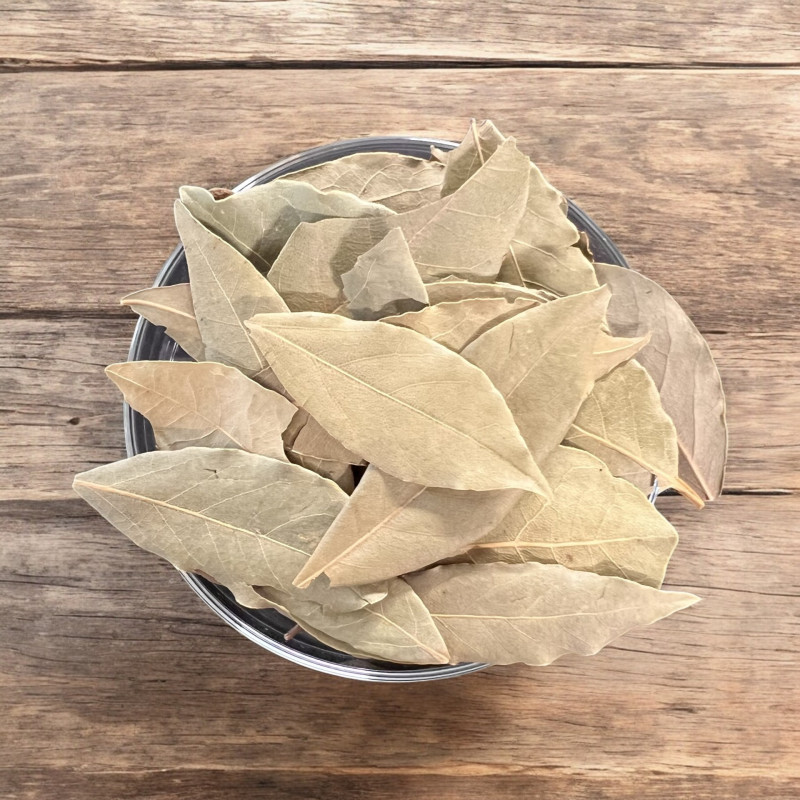- Reduced price



Its high essential oil content gives it a pine-inspired fragrance when the leaves are crushed.
Use Bay Leaves in sauces, broths, marinades, meats, vinegars, and mustards.
 Delivery
Delivery
Mondial Relay
 Returns
Returns
See conditions
 Payments
Payments
100% secure
Livré en sachet refermable
1) Who Am I?
Bay leaves (Laurus nobilis), also known as noble bay or laurel, are an aromatic plant native to Mediterranean regions. This large shrub, which can reach up to 15 meters in height, produces tough leaves rich in essential oils, used for centuries for their unique fragrance. Bay leaves are known for their woody and slightly resinous notes, reminiscent of pine, and for their mild yet intense flavor, adding a subtle touch to various dishes.
2) Culinary Uses
Bay leaves are an essential herb in cooking, particularly in slow-cooked dishes:
Bay leaves are often used whole and removed before serving. You can also crush them slightly to release their aroma more quickly.
3) A Little History
Bay leaves have always symbolized glory and victory. In ancient Rome, victors and emperors were crowned with laurel leaves, giving rise to the phrase “to receive laurels.” The term "laureate" is still used today to honor individuals for their achievements. Additionally, the word “baccalaureate” comes from the Latin "bacca lauri," meaning “bay berry,” referring to the laurel crowns awarded to medical graduates.
Beyond its culinary uses, bay laurel has also been used in making Aleppo soap, where laurel berry oil contributes to its moisturizing and antiseptic properties.
4) Recipe Ideas
Bay-Infused Fish Broth:
Ingredients: Water, bay leaves, carrots, onions, celery, thyme.
Preparation: Simmer all ingredients to create a fragrant broth, perfect for cooking fish or seafood. Bay leaves add a unique depth of aroma.
Beef Stew with Bay Leaves:
Ingredients: Beef chunks, red wine, bay leaves, carrots, onions, garlic, thyme.
Preparation: Simmer beef with red wine, carrots, and onions, adding bay leaves for extra flavor. Cook slowly to let the flavors infuse into the meat.
Sautéed Potatoes with Bay Leaves:
Ingredients: Potatoes, bay leaves, garlic, olive oil, salt.
Preparation: Sauté potatoes with a few bay leaves and garlic for a simple but flavorful side dish.
Bay-Infused Vinegar:
Ingredients: White wine vinegar, bay leaves.
Preparation: Steep a few bay leaves in white wine vinegar for several days to create an aromatic vinegar, perfect for salads and marinades.
Data sheet
 Virginie R.
Virginie R.
Très bien
 Sylvia P.
Sylvia P.
Produit satisfaisant
 CLAUDE N.
CLAUDE N.
Très mauvaise qualité, remboursement et réactivité sur après vente très satisfaite

 Virginie R.
Virginie R.
Très bien
 Sylvia P.
Sylvia P.
Produit satisfaisant
 CLAUDE N.
CLAUDE N.
Très mauvaise qualité, remboursement et réactivité sur après vente très satisfaite

Reference: 20731803
Reference: 2071570
Reference: PL-EK0-07
Reference: 6K4878201
Reference: 3N7201902
Reference: 9K5061101
Reference: 121320001
Reference: gentiane
Reference: 6N7456401
Reference: 11N7866301
Reference: 408164502
Reference: 112930001
Reference: aubepinefl
Reference: angelique
Reference: 7K4954201
Reference: 20731803
Reference: 9N7669901
Reference: 6L5609803

Its high essential oil content gives it a pine-inspired fragrance when the leaves are crushed.
Use Bay Leaves in sauces, broths, marinades, meats, vinegars, and mustards.